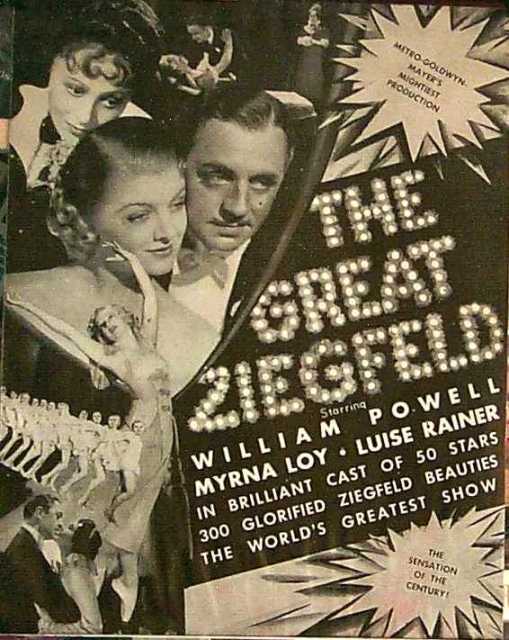Metro-Goldwyn-Mayer; the difference is that between biography and ì
autobiography. So thoroughly Ziegfeldian is The Great Ziegfeld, which had its ì
premiere at the Astor Theatre last night, that it would be easy to pretend it ì
had been produced by the Great Glorifier himself rather than by Hunt ì
Stromberg. For the picture has the opulence, the lavishness, the ì
expansiveness, and the color of the old Follies; it has the general ì
indifference to humor which was one of Ziegfeld's characteristics; and it has ì
the reverential approach with which, we suspect, Mr. Ziegfeld might have ì
handled his own life story.
That story is a full three hours in the telling and, if you have an interest ì
in the sordid financial details, it is reported to have cost Metro about ì
$500,000 an hour. The budget shows on the screen. It is there in the cast, ì
with William Powell, Myrna Loy, Luise Rainer, Virginia Bruce, Frank Morgan, ì
Fannie Brice, Ray Bolger, Reginald Owen, Ernest Cossart, Harriet Hoctor, and ì
the many others who prompted the studio's weaker students of astronomy to ì
advertise their wares with a "more stars than there are in the heavens" ì
slogan. It is there, too, in the glittering sets, the exuberantly extravagant ì
song and dance numbers, the brilliant costumes, the whole sweeping panoply of ì
a Ziegfeld show produced with a princely disregard for the cost accountant.
What William Anthony McGuire has attempted in his screenplay, and with ì
general success, is to encompass not merely the fantastic personal history of ì
Ziegfeld but the cross-sectional story of the development of the Follies, ì
the Midnight Frolic on the New Amsterdam Roof, and the other theatrical ì
enterprises floated under the Glorifier's aegis during a span of about forty ì
years. The two biographies-of the man and of his creations-are, naturally, ì
inseparable; but both have been told with such wealth of detail and ì
circumstance (real and imaginative) that even the three-hour film narrative ì
is fragmentary and, in some places, confused.
The picture begins with Ziegfeld (portrayed by Mr. Powell) exhibiting Sandow, ì
the strong man, on the Chicago midway, and it follows him as he progresses ì
from sideshow entrepreneur to head of his vast theatrical enterprises. The ì
history devotes ample footage to his meeting with Anna Held (Luise Rainer), ì
their romance and parting; to his launching of the Follies in 1907; his ì
alternate rise and fall on the tides of fortune; his marriage to Billie Burke ì
(here Miss Loy); his bankruptcy; and his death almost four years ago after ì
staging a successful comeback.
Although it has been screened with a chromatic eye for detail and setting and ì
has been enlivened by the performances of its players, this phase of the film ì
might-it seemed to me-have been abridged by producer Stromberg and Robert Z. ì
Leonard, its director, to admit more such incidents as the briefly narrated ì
but rousingly comic hiring of Fannie Brice, the dancing of Ray Bolger, and ì
the presentation of some other well-known alumnae and alumni of the Ziegfeld ì
shows. It was unfortunate that Eddie Cantor had to be represented by a proxy ì
(Buddy Doyle) and we would have been better pleased without A. A. Trimble's ì
impersonation of Will Rogers. A glimpse of W. C. Fields would have been ì
perfect, but Metro probably couldn't arrange everything.
Adhering to its Ziegfeldian tenets, however, the picture achieves its best ì
moments in the larger sequences devoted to the Girls-ballet, chorus, and ì
show. At least one of these spectacular numbers, filmed to the music of ì
Irving Berlin's "A Pretty Girl Is Like a Melody," with overtones of "Rhapsody ì
in Blue," never has been equaled on the musical comedy stage or screen. And ì
some of the others, notably the circus ballet led by Harriet Hoctor, are ì
scarcely less effective. The score generally was plucked from the catalogue ì
of hits in the old Ziegfeld shows and contains, as well, "Yiddle on Your ì
Fiddle" and "My Man," sung by Fannie Brice, and "I Wish You'd Come and Play ì
with Me" and "It's Delightful to Be Married," sung rather pleasantly by Miss ì
Rainer.
Confronted with a film of this size-not merely in volume, but in its ì
Croesus-like treatment-it is almost impossible to remain critically detached. ì
If the picture overcrowds its screen, at least we must admit it is an ì
impressive kaleidoscope; and probably nothing short of that could reflect the ì
gaudy career of America's foremost showman.
Mr. Powell's portrayal is no less attractive than it is flattering to the ì
original. Miss Loy is a stately Billie Burke, and somewhat lacking, we fear, ì
in Miss Burke's effervescence and gaiety. Miss Rainer continues to justify ì
the epithet winsome, but is inclined to emotional excesses which are not ì
entirely justified and frequently were extremely trying. Frank Morgan is ì
splendid, as usual, as Billings, a composite of several Broadway theatrical ì
producers, and there is valuable assistance from Virginia Bruce, as an ì
equally composite showgirl; from Reginald Owen as Ziegfeld's business ì
manager; and Ernest Cossart as his valet." (Frank S. Nugent, New York Times, ì
April 9, 1936)
 Plakatmotiv The great Ziegfeld, © Metro-Goldwyn-Mayer (MGM)
Plakatmotiv The great Ziegfeld, © Metro-Goldwyn-Mayer (MGM)